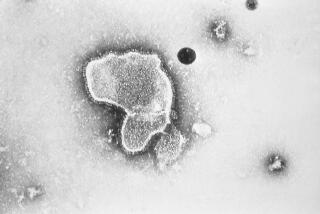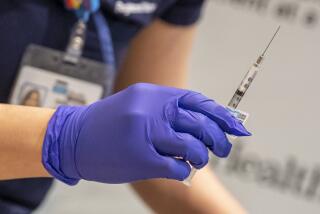Promising Tests Reported for New TB Vaccine
UCLA researchers have developed a prototype vaccine that prevents tuberculosis in animals that they say has great promise for use in humans.
The development comes at a time when the United States and other countries are increasingly facing the emergence of TB strains that are resistant to the drugs now used to control its spread. There have already been 12 outbreaks of multiple-drug-resistant TB in the United States, including one at an Orange County high school, according to John D. Foulds, tuberculosis and leprosy program officer at the National Institute of Allergy and Infectious Diseases.
“The bottom line is that we need a vaccine to help us in the fight against emerging drug resistance,” Foulds said. The UCLA team “is doing really sentinel work on this.”
The new vaccine contains no live bacteria and thus has many advantages over the existing vaccine, called BCG. BCG is not routinely used in the United States because it represents a major health risk for AIDS patients and others with compromised immune systems and interferes with public health programs for tracking tuberculosis infections.
Dr. Marcus A. Horowitz and his colleagues at the UCLA School of Medicine report today in the Proceedings of the National Academy of Sciences that they have developed a vaccine based on purified proteins from BCG that is at least as effective as the existing vaccine in preventing tuberculosis in guinea pigs, but that should have none of BCG’s risks.
Although further animal testing will be required, Horowitz said he hopes to begin human trials of the vaccine in as little as two years.
Horowitz’s report is “a very important development,” according to biochemist Thomas Shinnick of the Centers for Disease Control and Prevention, because it is the first demonstration that a vaccine containing no bacteria can actually be effective.
Tuberculosis commonly destroys tissues in the lungs, but affects other organs as well, including the liver, kidney, lymph nodes and brain. It is the world’s leading killer of adults, with 28,000 new cases detected annually in the United States and 8 million worldwide. Three million people die of it every year when their organs fail. The disease spreads rapidly because it is carried by airborne bacteria.
As recently as the early 1980s, public health authorities thought that tuberculosis had been eradicated in the United States. But in 1986, the number of new cases of TB rose in this country for the first time since 1953.
New cases have been growing every year since, fueled by the AIDS epidemic and TB among immigrants. The National Institute of Allergy and Infectious Diseases estimates that 10 million Americans have been infected by the bacterium. Such infections can persist indefinitely without causing disease.
BCG, which has been used since 1906, is a form of the bacterium that causes tuberculosis in cows. It has been weakened in the laboratory to reduce its disease-causing potential, but it has the ability to suppress an infected individual’s immune system.
Another problem is that the bacterium apparently mutates so that the vaccine is not the same from lot to lot. Some clinical trials have demonstrated that the vaccine provides no protection at all, while others have shown it to reduce tuberculosis by as much as 70%.
Furthermore, an individual who has been vaccinated with BCG produces a positive response to the tuberculin patch test, which is used as the primary tool for diagnosing the disease. Widespread use of the BCG vaccine, said the disease control center’s Shinnick, “would destroy our ability to survey for recent infections.”
And finally, a vaccinated individual sheds live bacteria for as long as several weeks. Those bacteria can cause severe disease in AIDS patients and others whose immune systems are already depressed.
Horowitz and his colleagues set out to circumvent those problems by isolating individual proteins from the BCG bacteria and using them as a vaccine that primes the immune system so that it responds instantly to a future infection by the bacteria. This approach has been successfully used for several existing vaccines, including one for hepatitis B. Horowitz himself used it to develop an effective vaccine for legionnaire’s disease, although no manufacturer has yet been willing to fund clinical trials of that product.
Horowitz was working against the conventional wisdom, Shinnick said, because TB researchers have long believed that only a vaccine containing live bacteria could provide protection. “Marcus is the first person to convincingly demonstrate that you don’t have to (use live bacteria)”--that using just a part of the bacterium is equally effective.
In several different experiments, Horowitz and his colleagues immunized groups of six guinea pigs with combinations of one to five purified BCG proteins and compared them to control animals given a sham vaccination. The animals were then exposed to a highly virulent TB strain. To analyze effectiveness, the researchers monitored weight loss, the number of TB bacteria growing in the animals’ lungs and deaths of the guinea pigs.
They found that though vaccination did not completely prevent infection by the TB bacteria, it did dramatically reduce it. Analysis of the lungs of the guinea pigs showed the presence of only 10% as many bacteria in those that had been vaccinated as in controls.
More important, vaccination prevented disease. Weight loss is a prime symptom of TB, and animals given a sham vaccination lost 11% to 25% of their body weight. Vaccinated animals, in contrast, lost much less and, in some cases, even gained weight. In another experiment, 50% of control animals died, while none of the vaccinated animals did.





